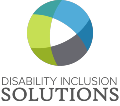Technology has changed the landscape of the workplace. And assistive technology has redefined employment for people with disabilities. It can help employees with different disabilities perform job tasks they might not otherwise be able to do.
Workers with visual disabilities now have screen readers available to them. These devices provide speech and Braille output for certain computer applications, and allows users to navigate the internet, write a document, read an email, and create presentations.

For employees with hearing disabilities, there’s technology that transcribes one-to-one or group conversations being spoken on smartphones or tablets.
Voice recognition software can be of great help for employees with physical disabilities. The software allows users to speak commands to operate their computers.
There are many assistive technologies available to help people with disabilities succeed in the workplace. The iDisability® module “Assistive Technology in the Workplace,” outlines the types of devices and services available for employees with disabilities. It also explains the type of settings in which these accessibility options are commonly used, and which devices are most appropriate for various workplace situations.
Assistive technology (AT) is playing a substantial role in creating a more diverse and inclusive workplace, as is iDisability®. Over 4 million business users across a variety of industries have already adopted iDisability’s® 38 distinctly different and practical modules to expand their disability practices, better serve their customers, and develop their brand. Experience it for yourself. Explore the benefits of e-learning while learning more about the the history of the disability civil rights movement for free.






0 Comments